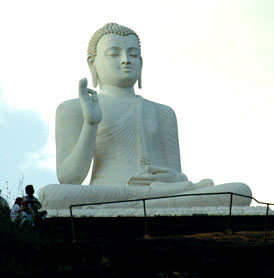|
Variety
Mihintale glows with sanctity at Poson


* Arahat Mahinda delivered the
Cula Hatthipadopama Sutta (the fundamental tenets of Buddhism
after King Devanampiyatissa's intelligence was tested.
* The delegation that came
along with Arahat Mahinda are the four Buddhist monks, Ittiya,
Uttiya, Sambala and Bhaddasala, Sumana the novice monk and the
acolyte Bhanduka, a devout Buddhist layman.
* Bhanduka was the first
Arahat in Sri Lanka. He was granted the lesser (Pabbajja) and
higher (Upasampada) ordination by the Sangha.
* Mihintale is situated
about eight miles away from Anuradhapura. |
With the spiritual fragrance of the Thrice Blessed Day still fresh in
their hearts and minds, Buddhists in our country are now preparing to
usher in yet another day of religious significance, unique to our
Motherland. Perhaps, if not for the events that took place on this
hallowed day in June long ago, Vesak or the Thrice Blessed Day may have
not been so significant to the people of this land, as it is today.
The month of June unfolds like a blossom, the story of the birth of
Buddhism in this land, which took place thousand of years ago on a Poson
Full Moon Poya Day.
The Enlightened One's hallowed teachings, the Dhamma was introduced
to this little island nation of ours by none other than a supremely
enlightened Buddhist Monk, Arahath Mahinda Thera, son of the Great
Mauryan Emperor of India, King Asoka. Arahat Mahinda, the Missionary
Prince is said to have alighted on the Sila-peak, which is the northern
peak of the Mihintale Mountain during the reign of King Devanampiyatissa
(B.C. 247-207).
It was on this summit that the Arahat confronted the famous deer
hunter who was pursuing a stag to the top of the hill and tested the
King's capacity for instruction with a riddle, pointing to a mango tree
growing nearby.
By now even non-Buddhists are familiar with the dialogue that took
place between the King and Arahat Mahinda on that summit and the events
that followed to make King Devanampiyatissa his first convert.
Thereafter Buddhism spread far and wide in this land with royal
patronage during that time. Today it continues to do so, under State
patronage.
With the dawn of Poson, Mihintale becomes the centre of attraction
today not only because Arahat Mahinda first set foot on this place and
succeed to convert the people of this land to Buddhism, but also because
the sacred relics of the Buddha, (on His instructions given prior to
Parinibbhana) were brought over from India and kept here originally
until suitable structures were raised elsewhere to enshrine them.
It is also the place where the relics of the Missionary Prince -
Mahinda were also eventually enshrined after He passed away. So, these
three significant factors and the colossal, stupendous edifices
constructed by the ancient kings during different eras, add to the
grandeur and glory of Mihintale during the month of Poson.
The cradle of Buddhism, Mihintale, steeped in history becomes a hive
of religious activity during the Poson season. The gigantic Ambasthala
Thupa or dagaba will be brightly illuminated lighting the way for the
thousand of devotees who will flock to this place on Poson Poya Day,
which falls on June 25 this year.
  Among
the many antiquities to be seen at the Mihintale sacred hill and
surrounding area, the most fascinating is the ancient stairway
comprising 1,840 worn out stone steps that seem to be reaching almost
into the azure sky when looked at from the base of the mountain. Among
the many antiquities to be seen at the Mihintale sacred hill and
surrounding area, the most fascinating is the ancient stairway
comprising 1,840 worn out stone steps that seem to be reaching almost
into the azure sky when looked at from the base of the mountain.
Many of you may have ascended these stone steps to reach the summit
with reverent awe.There are many historic places to see at Mihintale
apart from the Ambasthala Dagaba.
They are the 40-foot Kantaka Cetiya, Stupa built by King Suratissa,
the ruins of a Veda Sala (hospital) at the foot of the mountain with a
medicinal bath (beheth oruwa) in the shape of a human strongly
resembling a sarcophagus, stone inscriptions or the inscribed slabs of
Mahinda IV (A.D. 956-972) described by Bell as being probably the finest
example of a Sinhalese inscription prior to the reign of Nissanka Malla.
(It bears a long record of temple regulations and privileges), the
famous lion bath, the ruins of the monastery Indi-Katu Vehera, Ran Giri
Lena Kanda, and the entrancing Kaludiya Pokuna.
If you have not made a trip to Mihintale, then don't hesitate to do
so during the Poson season, especially if you are a Buddhist, because it
is then that this magnificent place which is considered to be the cradle
of Buddhism could be seen in all its glory and splendour. |

